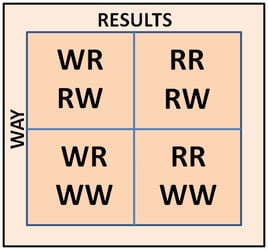Sales Performance Assessment: Get the Right Results the Right Way
 In selling, there’s a ready-made metric to determine whether a seller is performing or not. Quotas are set, sales are made, and a simple comparison lays out whether the seller is above, at, or below the expected sales performance level.
In selling, there’s a ready-made metric to determine whether a seller is performing or not. Quotas are set, sales are made, and a simple comparison lays out whether the seller is above, at, or below the expected sales performance level.
For many sales organizations, that’s all there is to to a sales performance assessment.
When the measure of a seller’s performance is that cut-and-dried, the numbers do all the work. Sellers who underperform for any length of time are let go. Sellers who attain or exceed their goals are rewarded with commissions, special incentives and additional opportunities.
At times, the sellers who excel and make their numbers leave a path of destruction in their wake both internally and externally. But since they are the top performers, sales managers turn a deaf ear to those complaints.
Download: Increase Employee Engagement & Productivity [CHECKLIST]
Sales Performance Assessment Should Focus on Getting the Right Results the Right Way
There is a better way to do a sales performance assessment and set expectations for sellers. It involves looking at more than the quota number and how the seller delivers on that number. For that reason alone, many sales organizations reject this approach. It’s too much work.

This box model illustrates a more comprehensive look at what a seller should do in service of his customers and his company. This is known as “getting the right results the right way.”
Getting the right results remains an imperative. The right results includes (and may be limited to) reaching sales targets. No one who consistently misses goals should expect to stay in a sales position. Companies need the sales numbers built into those goals in order to deliver on shareholder expectations.
But when a company adds “right way” to “right results” and handles sales performance assessments accordingly, there are big benefits.
First, a seller has a clear picture of HOW to achieve what is expected.
Second, by putting into context those expectations, a sales manager has an ability to assess performance on multiple levels. So when a top performer hits their numbers but does so without regard for deadlines, proper protocols, respect for co-workers and support departments, or without ethics, there is more to talk about than “but she’s our top performer.”
Finally, the “right way” protects the company’s image and ensures long-term customer satisfaction.
What Should Your Sales Performance Assessment Look Like?
What is the “right” way? Each sales organization should define that very specifically. It would include how customers are to be treated, what the ground rules are for internal handoffs, how the company is to be represented, what the ethical boundaries are, and what sales processes or tools are to be used. The “right way” may also include standards for pricing, contracts, legal issues, and so on.
Once the sales team knows how their organization defines both “right results” and “right way,” they will have a newfound sense of clarity. They will feel that they’ve been pointed in the right direction. They will appreciate having standards that go beyond the latest sales numbers. And if there are issues with internal competition or perceived abuses of support department personnel, defining “right way” will also enable the team to work together more cooperatively.
The box model gives sales managers a nifty new tool to assess members of their team, too. With this, a sales manager now has four categories rather than two for identifying where a salesperson currently is. Without “right way,” all the manager had to go by was "did meet" or "did not meet" quota. The rest of the story was missing.
With the addition of “right way,” the four choices are “Wrong Results, Right Way” (upper left hand corner), “Right Results, Right Way” (upper right hand corner), “Wrong Results, Wrong Way” (lower left hand corner), and “Right Results, Wrong Way” (lower right hand corner). Each of these choices provides much more to consider than just whether or not someone reached goal. One by one, you’d consider:
Wrong Results, Right Way – Here’s someone who’s trying and will, most likely succeed in time. When you do things the right way it should lead to the right results. A manager should coach and support this seller.
Right Results, Right Way – This is the true superstar of the team. A manager should celebrate the seller’s success in making goal AND highlight the ways this seller goes about doing business.
Wrong Results, Wrong Way – This one is a no-brainer. Can an organization afford to keep this type of seller around? If corrective measures don’t result in a quick turnaround, managers should take action.
Right Results, Wrong Way – This is the one that causes resentment when recognized or rewarded. Managers should be careful about the message they send when they ignore how things were done and focus solely on the results. Too much of this impairs the organization’s long-term effectiveness.
As a seller, you may wish to consider which “right ways” could help you achieve results and/or serve your organization well. Focusing on the right results as well as the right ways makes you a keeper.


